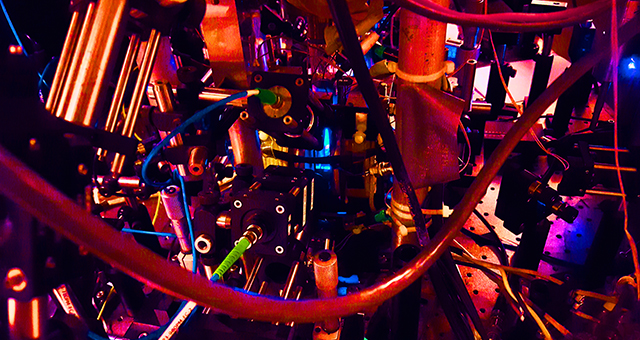By: Jon Farrow
22 Jul, 2020

Aephraim Steinberg, co-director of CIFAR’s Quantum Information Science Program, led a team that timed atoms’ mysterious quantum behaviour.
How long does it take to do the apparently impossible? Knowing might unlock better quantum computers and a deeper understanding of physics.
The fact that quantum-scale objects like atoms or photons can appear on the other side of apparently insurmountable barriers would not surprise most quantum physicists. This effect, known as quantum tunnelling, was first reported in the 1920s. It’s so well-established that we harness it for advanced microscopes and quantum computers and we now know it is essential for photosynthesis and nuclear fusion.
“We wouldn’t even be here if not for tunnelling,” says Aephraim Steinberg, the co-director of CIFAR’s Quantum Information Science program and a professor of physics at the University of Toronto. “The first steps in fusion in the sun require one nucleus to tunnel into another nucleus. So tunnelling is a very fundamental process that actually happens in the universe, not just in quantum mechanics textbooks.”
The details of this phenomenon, however, remained mysterious. For 90 years, physicists have argued about how exactly this tunnelling happens, what the atoms do as they tunnel, and how long they take to make the journey.
Steinberg’s team, seeking to provide clarity on how long particles spend tunnelling, timed how long ultracold rubidium atoms took to tunnel through a micron-thick laser beam that should have reflected them. In a paper published in Nature in July 2020, they reported a result of about one millisecond.
This breakthrough, built on nearly 20 years of refining experiments in his lab, is the world’s first such measurement and uncovers deep truths about the physical laws that govern quantum interactions.
“Steinberg and co-workers have accessed a very deep, hidden domain—the classically forbidden region where quantum tunneling prevails—providing further insight into what information can ultimately be known about a physical system,” says Irfan Siddiqi, an expert in quantum control, a fellow in CIFAR’s Quantum Information Science program, and a professor of physics at the University of California Berkeley. “Developing new measurement methods that access long-lived, unique quantum signatures are key to developing advanced quantum information processing architectures.”
To examine quantum tunnelling, Steinberg’s team set up a system where they would push atoms of rubidium, which they had cooled down to a billionth of a degree above absolute zero, into a laser barrier.
Listen to Aephraim Steinberg explain the experimental set-up that allowed his team to time atoms’ tunnelling.
“We made one beam [of light] that acted like a guiding fibre for the atoms and held them in this line. Then we intersected that with a second beam that we set up so that it would repel the atoms,” says Steinberg. “That second beam acted like a barrier, and we could very carefully adjust the “height” of that barrier. Our setup also allowed us to give the atoms a little push so we could adjust whether or not they had enough energy to classically surmount the barrier.”
They chose the alkali metal rubidium as their tunnelling clocks because its atoms flip back and forth between two states in a precise and predictable way. Indeed, the oscillations of a related atom, cesium, define the second. Mathematically, this oscillation can be treated like a clock hand that points in a certain direction and can move over time.
“Since we wanted [the atoms’ clock hands] to only tick in that one micron region where the barrier is, we used the barrier light itself to also tickle the spin of the atoms and make it oscillate at a frequency that we knew,” explains Steinberg.
Once they had particles that could tunnel, the particles carried clocks, and the clocks only ticked when they were in the barrier, they had to take photographs that showed where the clock hands were pointing once they reached the other side in order to calculate the amount of time the atoms must have spent in the barrier.
“This whole idea of probing the history of a quantum particle is one that’s been central to my research and it’s come up over and over again in discussions at CIFAR program meetings,” says Steinberg, who was appointed a fellow of the Quantum Information Science Program in 2003 and became co-director during the program’s renewal in 2018. He has been thinking about, building, testing, and iterating on this delicate and complex experiment since 2001.
“There is no free lunch in quantum mechanics,” says Siddiqi. “For example, a route to robustly store information in quantum systems is to hide it from the classical world, thereby creating a fundamental engineering challenge in developing hardware where quantum coherence is long-lived yet controllable.”
The result is not only proof that it is possible to time the tunnelling process, but also that there is much more to learn to get the full picture of quantum systems. It will spur new ideas about what can be learned about a quantum particle’s past from observations in the present in CIFAR’s Quantum Information Science Program, which brings together theorists and experimentalists to address the field’s most fundamental questions.
“This had been kind of a niche topic in quantum optics,” says Steinberg. “But I think as the technology evolves, and as we’re building these larger scale agglomerations of qubits and trying to learn how to characterize and control each of them, this has renewed practical importance.”

Measurement of the time spent by a tunnelling atom within the barrier region was published in the journal Nature on July 22, 2020.
CIFAR’s Quantum Information Science program aims to understand the fundamental science behind quantum information in order to discover how best to harness it, solve important computational problems, and develop new insights into physics and information. The program takes a broad interdisciplinary approach, bringing together physicists, computer scientists, and others working in connected disciplines in order to address the field’s most fundamental challenges.